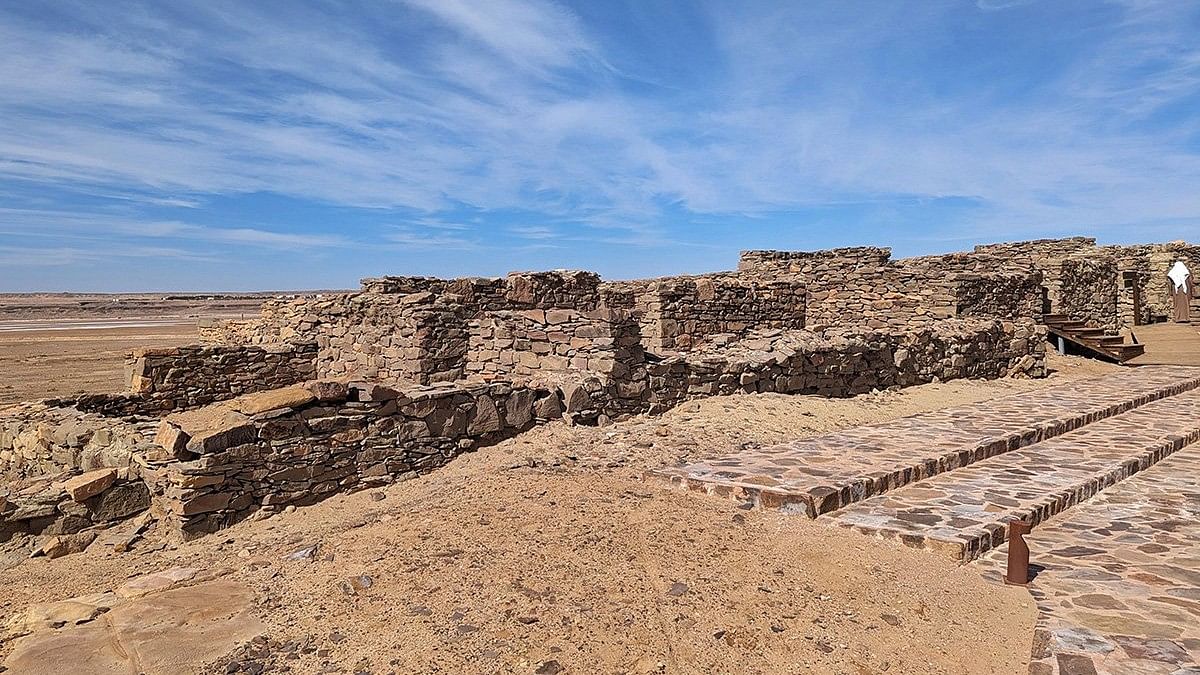
The Temple of Salm is devoted to the Moon God.
Credit: Kunal Bhatia and Shuvajit Payne
A three-hour drive winding through the breathtaking volcanic desert landscapes of north-western Saudi Arabia brought us to Tayma. Stepping into this historic city, which is even mentioned in the Bible, we didn’t expect much more than a walk through some ruins. Little did we know of the sensory journey through time that awaited us!
Right in the centre of the old town stands a fine restoration of an early engineering wonder, which at first sight appears to be only a stack of bullock cart wheels hoisted above stone walls. However, as we were to discover, this is the 2,500-year-old Bir Haddaj — one of the largest water wells in the Arabian Peninsula. For centuries, this well served as a lifeline for the inhabitants of Tayma, as well as for merchants travelling across the Incense Route of yore. The imposing structure stretches 18 metres in diameter and has as many as 40 wheels to draw out the water.
Restored to its original glory by Prince Faisal Al-Saud, the well today is kept functional for an immersive experience for onlookers, with camels laboriously working the wheels and men in traditional thawbs drawing the water out from the depths. The rhythmic creaks of wooden pulleys, the splashes of water being thrown into channels, the gentle grunting of camels, and the scent of wet earth amidst the desert heat, bring to life the scale and ingenuity of this ancient contraption, which is said to have once engaged close to one hundred camels and wheels for its operation!
In fact, the region boasts a rich history dating back to the Palaeolithic era, with archaeological excavations revealing evidence of human activity and fossils as far back as 90,000 years. Rising to prominence as a crucial stopover for trade caravans, Tayma became renowned for lush plantations of date palms and fragrant aromatic plants, consequent of canal irrigation through its abundant wells. Its strategic location at the crossroads of civilisations attracted the attention of powerful kingdoms and empires throughout history, including the Assyrians, Babylonians, Nabataeans, Romans, and Ottomans.
Today, Tayma finds itself once again in the spotlight, but this time with the rumble of caravans replaced by the hum of eager visitors like us. The city’s commitment to conservation is evident and has a noticeable theatrical flair. We were greeted with local delights such as dates, figs, and almonds. A celebratory dance of the traditional folkloric Ardah followed, with men in traditional attire standing shoulder to shoulder carrying drums and swords, and moving in unison to the beats. Right in front of us, a live street performance broke out recreating the bustling markets trading frankincense and myrrh, fabrics and spices, gemstones and jewellery. On weekends, twice a day, this vivid scene unfolds as actors bring to life royal characters, recounting the city’s rich history amidst a grand production
featuring camels, horses, and chariots!
A short walk away, in another impressive dramatisation, the soldiers of Nabonidus, the last king of the Neo-Babylonian Empire, welcome us into the Tayma Fort, with the ‘king’ himself explaining its heritage while we are seated in the royal hall. Built in the 1700s, the Qasr Ibn Rumman Palace has a distinctive Nejdi mud-brick style architecture and boasts a massive defensive wall crafted from stone and flour.
Tayma and its surroundings have proven to be quite a treasure trove for historians and archaeologists, with findings revealing close connections to Egypt and Mesopotamia. To the northwest of the city are the ruins of the 6th century BCE Al Hamra Palace. Nabonidus resided for many years in this stone structure, perched at the edge of a rocky ridge, overlooking an ancient salt lake.
Theories ranging from illness to madness, to an interest in religious archaeology, make way for enigmatic tales. The site houses the ancient Temple of Salm, devoted to the Moon God. This remarkable 3,000-year-old Iron Age temple complex lay buried for centuries until its rediscovery in the 1970s. Among the remarkable ancient finds here are the motif-covered AlHamra Cube and the AlHamra Stele, which are currently displayed at the National Museum in Riyadh.
For the intrepid explorer equipped with a 4x4 vehicle to tackle the sands, there’s even more to discover in the trail of rock art at sites like Al Naslaa, Al Daksh, Jebel Habib, and Uqulqh. Alternatively, one can indulge in a leisurely stroll around the artefact-filled Tayma Museum, relax in a sit-out beneath the shaded date palms of 300-year-old Souq Al Najm, or feast on classic Saudi Arabian dishes like the aromatic chicken mugalgal in the open-air Mirzam restaurant — conveniently located right in front of the Bir Haddaj well.
From either of the airport cities of Tabuk or AlUla, Tayma is a worthy day trip with a recommended stop midway to share a cup of fragrant Arabic coffee with a Bedouin family!